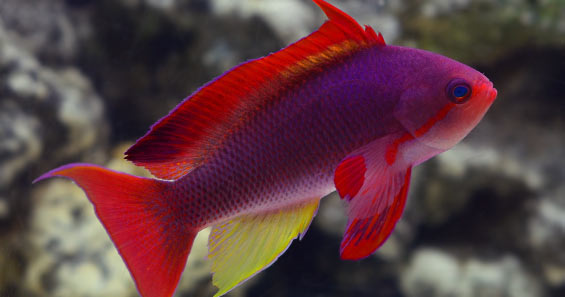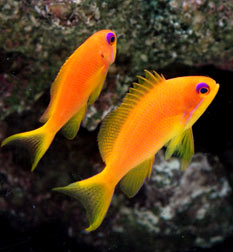
There is nothing like the sight of a shoal of anthias shrouding the top of a coral pinnacle or a reef face promontory! I will never forget the first dive I did on such a site. When I returned home to land-locked Nebraska, I was determined to recreate this reef scene in my living room. At that time (1986), very few anthias species were encountered in fish stores. The most ubiquitous species in the aquarium trade was the
Lyretail Anthias (Pseudanthias squamipinnis). I acquired one beautiful male and three females and introduced them to my 55 gallon aquarium. Unfortunately, these fish which seemed so gregarious in nature, were not so social in the confines of their new home. Before long, all I had left was one very boisterous male!
Many species of anthias are now available to the home aquarist - just check out the
Diver's Den® and you will see what I mean! Their current abundance is a function of their popularity with reef aquarists. Because they're not a threat to any ornamental invertebrates they're a great addition to the reef tank. But there are a number of husbandry requirements that you should consider before you purchase an anthias for your reef or fish-only aquarium. In this article, we will examine some of the aquarium needs of the members of the anthias genus Pseudanthias.
 What is an Anthias?
What is an Anthias?
Although it may be hard to believe, the anthias are members of the grouper family (Serranidae). This relatively large, diverse family contains some of the largest of all the bony fishes, as well as some true Lilliputians. The anthias belong to the subfamily Anthiinae. Most of the members of this subgroup are small, colorful reef-dwellers that form groups or shoals over the reef where they capture minute food items carried by ocean currents. The subfamily includes 17 genera and approximately 170 species.
The most common group in the subfamily is the genus Pseudanthias (with about 60 species). While most ichthyologists/aquarists refer to members of this genus as anthias or fairy basslets, the genus name actually translates as "false" anthias (anthias means fish, so actually it is "false fish"). So why do we call them anthias if they are actually "false" anthias? The first member of the subfamily Anthiinae to be described was a resident of the northeast Atlantic and Mediterranean. This species, known as the common anthias (Anthias anthias), was described in 1758 by the "Father of Taxonomy" Carl Linnaeus. In subsequent years, more fish were described in this subfamily and many were placed in the genus Anthias. It was not until 1981 that ichthyologists decided that many of the species placed in the genus Anthias should be moved to a genus originally described in the 1850's by Dutch ichthyologist Pieter Bleeker. This was the genus Pseudanthias. By this time, the common name anthias was being used by researchers/writers for many members of the subfamily Anthiinae, including members of the genus Pseudanthias.
 Life of a Pseudanthias spp.
Life of a Pseudanthias spp.
Although a cloud of anthias hanging above a luxuriant coral reef may give the impression of serenity, life in an anthias shoal is really rather tumultuous. Unlike a school of neon tetras, where every individual is equal in social status (this is known as an egalitarian school), members of an anthias group are competing for a position in the group's pecking order (this is known as a shoal). Let's look at a typical
Lyretail Anthias (Pseudanthias squamipinnis) assemblage. This anthias forms shoals of varying sizes, from small, isolated groups that are scattered sporadically over the reef, to huge groups numbering in excess of 2,000 individuals, that cover immense sections of vertical reef face. These groups are comprised mainly of females and non-territorial males (these males hang toward the bottom of the group).
Within the anthias shoal, territorial males perform acrobatic U-swim displays and vigorously defend an area of the reef and an associated harem of females. Lyretail Anthias shoals from the Red Sea typically have one territorial male to every eight females. The size of the male's territory is a function of the female density, and can range from about 5 to 32 square feet in area (for comparison, a standard 75 gallon tank has a surface area of 6 square feet). Within the group of females, a dominance hierarchy exists, with larger individuals dominating smaller conspecifics. If the territorial male should die, the dominant female in the harem changes sex (they are protogynous hermaphrodites) in as little as two weeks and will become the new territory holder. To maintain dominance, males and larger females display at, charge, chase and sometimes nip at their neighbors.
Part 1
What is an Anthias? |
| |
Part 2
Anthias Shoals in the Aquarium |
| |
Part 3
Feeding |
| |
Part 4
Aquarium Conditions & Tankmates |
| |
Part 5
Other Aquarium Anthias |

 Scott Michael
Scott Michael
Scott W. Michael is an internationally-recognized writer, underwater photographer, and marine biology researcher specializing in reef fishes, and was the Banquet Speaker at our 2007 and 2008 Coral Conference and Frag Swap. He is a regular contributor to Aquarium Fish Magazine, Freshwater and Marine Aquarium Magazine, SeaScope, and is the author of
Reef Fishes Vol 1,
Vol 2, and
Vol 3, Vol 4, and Vol 5.,
A Pocket Expert Guide Marine Fishes,
A Pocket Expert Guide to Reef Aquarium Fishes, 101 Best Saltwater Fishes: How to Choose and Keep Hardy, Brilliant, Fascinating Species That Will Thrive in Your Home Aquarium, Reef Sharks & Rays of the World, and Aquarium Sharks & Rays. Having studied marine biology at the University of Nebraska, Scott has served as a scientific consultant for National Geographic Explorer, the Discovery Channel, and French educational television.
|